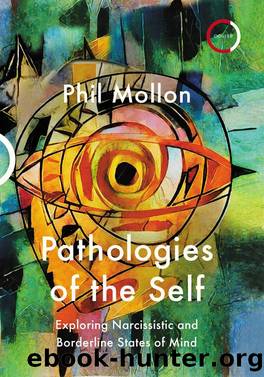Pathologies of the Self by Mollon Phil;

Author:Mollon, Phil;
Language: eng
Format: epub
Publisher: Confer Ltd
Published: 2020-06-15T00:00:00+00:00
Narcissism and sexual trauma
NARCISSISTIC INJURIES, SHAME, AND SEXUAL DEVELOPMENT
Narcissistic injuries are wounds to our self-esteem, resulting from humiliations, slights, shaming, feeling misunderstood, being treated without empathy or respect for individuality (Mollon, 1984, 1986, 1993). Some such wounds attack aspects of our core sense of identity and self-worth.
Narcissistic injuries are saturated with the emotion of shame. When we feel loved, accepted, and understood, the emotional tone of the experience is one of freedom and expansion. At such moments we may reach out uninhibitedly to connect with others and express warmth and affection. The primordial version of this is the baby at the breast, basking in the warmth of the motherâs smile and loving eyes. By contrast, if the mother is not smiling, or is detached, uninvolved, showing a blank face, or openly rejecting, the baby will retreat and display early indicators of shame (Tronick, Als, Adamson, Wise, & Brazelton,1978). When we experience rejection or an absence of acceptance, we feel shame. Our life energy does not flow outwards expansively, but instead retreats into reverse. This is the essence of shame, which is the core affect of narcissistic injury (Mollon, 1984, 1986, 1993, 2002).
One of the odd features of human sexuality is that it gathers around the deepest wounds to the self and creates a kind of healing by making these the focus of sexual excitement. Robert Stoller described this process in a series of books on sexuality (e.g., Stoller, 1976). Kohut observed similar developments, so much so that he referred to compulsive sexual fantasies as âsexualised statements about narcissistic injuryâ (1971, p. 71).
Kohut (1971) described Mr A, whose homosexual fantasies usually involved a theme of enslaving a strong and virile man whom he would masturbate and thereby drain of his power. According to Kohutâs understanding, these expressed in a sexualised form Mr Aâs longing for an infusion of strength and perfection from an idealised man, originally the father. What was missing was part of the inner structure of the self â the idealised values, and the potential self-esteem that comes from living up to these. In place of this inner structure, Mr A had substituted a sexualised sense of triumph in stealing qualities of power and strength from an external ideal. Kohut saw such âsexualised statements about narcissistic injuryâ as analogous to the theoretical formulations of the analyst, both of which are ways of representing the patientâs core narcissistic injuries and tensions â with the difference that the sexual fantasies are in opposition to insight and are created in the service of pleasure and relief from narcissistic tensions (which are not essentially sexual tensions, despite the surface appearance).
In another example, Mr E would often engage in dangerous voyeuristic pursuits, particularly gazing at other menâs genitals in public toilets, during separations from the analyst or when feeling misunderstood by the analyst. In the course of the analytic work, Mr E recalled the first episode of voyeurism as a young child. It took place at a country fair, when he had asked his mother to admire his skill when flying high on a swing.
Download
This site does not store any files on its server. We only index and link to content provided by other sites. Please contact the content providers to delete copyright contents if any and email us, we'll remove relevant links or contents immediately.
Should I Stay or Should I Go? by Ramani Durvasula(7435)
Why We Sleep: Unlocking the Power of Sleep and Dreams by Matthew Walker(6363)
Fear by Osho(4496)
Flow by Mihaly Csikszentmihalyi(4493)
Rising Strong by Brene Brown(4195)
Why We Sleep by Matthew Walker(4193)
How to Change Your Mind by Michael Pollan(4115)
Too Much and Not the Mood by Durga Chew-Bose(4097)
The Hacking of the American Mind by Robert H. Lustig(4092)
Lost Connections by Johann Hari(3929)
He's Just Not That Into You by Greg Behrendt & Liz Tuccillo(3719)
Evolve Your Brain by Joe Dispenza(3506)
The Courage to Be Disliked by Ichiro Kishimi & Fumitake Koga(3264)
Crazy Is My Superpower by A.J. Mendez Brooks(3208)
What If This Were Enough? by Heather Havrilesky(3199)
Resisting Happiness by Matthew Kelly(3197)
Descartes' Error by Antonio Damasio(3168)
The Book of Human Emotions by Tiffany Watt Smith(3145)
In Cold Blood by Truman Capote(3140)
